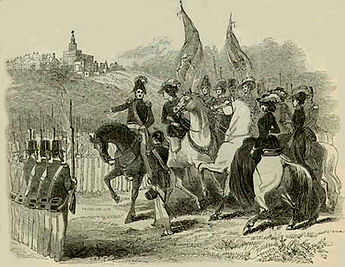| Nauvoo Legion | |
|---|---|
 General Joseph Smith commanding the Nauvoo Legion infantrymen in formation between 1841 and 1844 in Nauvoo, Illinois, with the Nauvoo Temple on a hill in the background | |
| Active | 1841–1845 |
| Country | |
| Allegiance | |
| Branch | Illinois State Militia (1841–1845) |
| Type | Militia |
| Role | Protect Mormon settlers from domestic and foreign enemies |
| Size | Illinois State Militia (2,500) |
| Engagements |
|
| Commanders | |
| Notable commanders |
|
| Part of a series on |
| Mormon Militias |
|---|
 |
The Nauvoo Legion was a state-authorized militia of Nauvoo, Illinois, United States from February 4, 1841 until January 29, 1845. Its main function was the defense of Nauvoo and surrounding Latter Day Saint settlements, but it was also occasionally used as local law enforcement and paraded at ceremonies such as the laying of the cornerstone for the Nauvoo Temple. The Nauvoo Legion was unique among contemporary militias for its chain of command structure, its expanded functions of the court martial, and for operating at a city level.
The Legion's presence was a significant factor in tensions between Nauvoo and its neighbors. The militia received criticism for its loyalty to Joseph Smith, founder of the Latter Day Saint movement and mayor of Nauvoo. In 1843, Legion members controversially helped Smith avoid extradition into Missouri. In 1844, Joseph Smith ordered the Nauvoo Legion to destroy the Nauvoo Expositor newspaper. Smith was charged with inciting a riot and placed in Carthage Jail where he was killed by a mob.
In 1845 the Legion lost its official sanction as an arm of the Illinois militia, though activities continued under command of Brigham Young until the expulsion of the Latter-day Saints from the state. The final conflict in Illinois involving remaining Legion members occurred in September 1846.